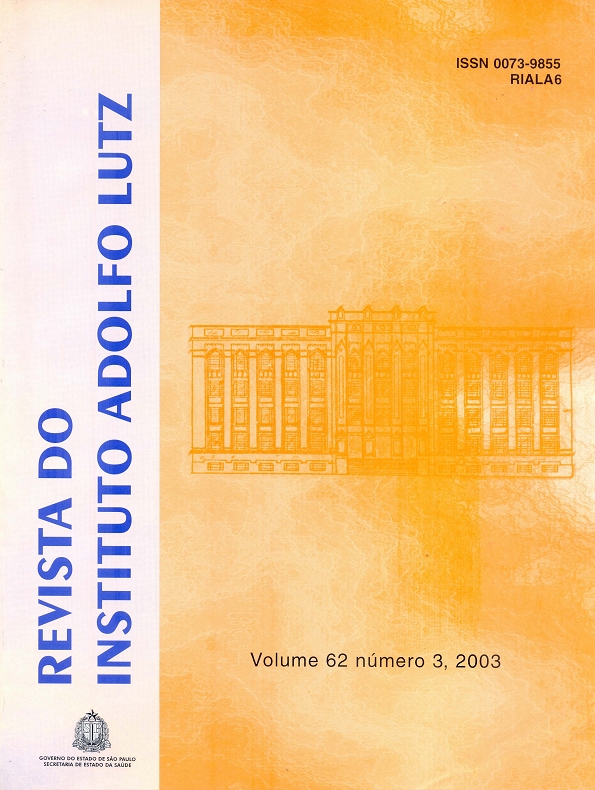Abstract
This work had the objective of quantifying the principal carotenoids of the watermelon,
cultivar Crimson Sweet, obtained from two producing states: São Paulo and Goiás. The samples were purchased during the year from the Central Distribution Center (CEASA) of Campinas, totalling five fruits analysed individually for each region. The analyses, carried out in duplicate, consisted of extraction with acetone, partition to petroleum ether and quantification by high performance liquid chromatography (HPLC) (C18 column, Spherisorb ODS2, 3 µm, 4.6 mm x 150 mm; isocratic elution, mobile phase of acetonitrile
containing 0.05% triethylamine: methanol:ethyl acetate (60:20:20); flow rate of 0.8 mL/min), using external standardization. The HPLC chromatogram revealed that the watermelon analyzed contained almost exclusively lycopene, with a small amount of β-carotene. The lycopene and β-carotene contents (µg/g) were, respectively, 36 + 5 and 4.7 + 2.4 for the fruits from São Paulo, and 35 + 2 and 2.6 + 1.7 for those from Goiás. The concentrations of these two carotenoids resembled those found in tomato, cultivar Carmen (35 + 10 µg/g for lycopene and 3.2 + 0.6 µg/g for β-carotene), showing watermelon to be an important source of lycopene. The difference in terms of place of production was not significant...
References
1. Astorg, P. Food carotenoids and cancer prevention: an overview of current research. Trends Food Sci. Tech., 8: 406–413, 1997.
2. Cavalcante, M.L.; Rodriguez-Amaya, D.B. Carotenoid composition of the tropical fruits Eugenia uniflora and Malpighia glabra. In: Charalambous, G. editor. Food Science and Human Nutrition. Amsterdam: Elsevier Science Publishers; 1992. p. 643-650.
3. Clinton, S.K. Lycopene: chemistry, biology, and implications for human health and disease. Nutr. Rev., 56: 35-51, 1998.
4. Di Mascio, P.; Kaiser, S.; Sies, H. Lycopene as the most efficient biological carotenoid singlet oxygen quencher. Arch. Biochem. Biophys., 274(2): 532-538, 1989.
5. Giovannucci, E. Tomatoes, tomato-based products, lycopene, and cancer: review of the epidemiologic literature. J. Natl. Cancer Inst., 91: 317-331, 1999.
6. Holden, J.M. et al. Carotenoid content of U.S. foods: an update of the database. J. Food Comp. Anal. 12: 169–196, 1999.
7. Hughes, D.A. Dietary carotenoids and human immune function. Nutrition, 17: 823-827, 2001.
8. Kimura, M.; Rodriguez-Amaya, D. B. A scheme for obtaining standards and HPLC quantification of leafy vegetable carotenoids. Food Chem., 78 (3): 389-398, 2002.
9. Kimura, M.; Rodriguez-Amaya, D. B.; Yokoyama, S.M. Cultivar differences and geographic effects on the carotenoid composition and vitamin A value of papaya. Lebens Wissen Technol., 24: 415-418, 1991.
10. Krinsky, N.I. Carotenoids as antioxidants. Nutrition, 17: 815-817, 2001.
11. Le Maguer, M.; Shi, J. Lycopene in tomatoes: chemical and physical properties affected by food processing. Crit. Rev. Food Sci. Nutr., 40(1): 1-42, 2000.
12. Niizu, P.Y.; Rodriguez-Amaya, D.B. (resultados ainda não publicados)
13. Olson, J.A. Carotenoids and human health. Arch. Latinoam. Nutr., 49(1): 7S-11S, 1999.
14. O’Neill, M. E. et al. A European carotenoid database to assess carotenoid intakes and its use in a five-country comparative study. Brit. J. Nutr., 85: 499–507, 2001.
15. Padula, M.; Rodriguez-Amaya, D. B. Characterisation of the carotenoids and assessment of the vitamin A value of Brazilian guava. Food Chem., 20: 11-19, 1986.
16. Paetau, I. et al. Chronic ingestion of lycopene-rich tomato or lycopene supplements significantly increases plasma concentrations of lycopene and related tomato carotenoids in humans. Am. J. Clin. Nutr., 68: 1187-1195, 1998.
17. Perkins-Veazie, P. et al. Lycopene content differs among red-fleshed watermelon cultivars. J. Sci. Food. Agric., 81: 983-987, 2001.
18. Porcu, O.M.; Rodriguez-Amaya, D.B. Goiaba (in natura) e produtos processados como fonte de licopeno. Resumo apresentado no 5º Encontro de Química dos Alimentos, Porto, Portugal, 2001.
19. Programa de Desenvolvimento da Fruticultura. Ministério da Agricultura, Pecuária e Abastecimento, [http://www.agricultura.gov.br/sarc/profruta/html/mercadocap4a.htm]. 21 junho 2003.
20. Queiróz, M.A. et al. Recursos genéticos e melhoramento de melancia no nordeste brasileiro. Embrapa, [http://www.cpatsa.embrapa.br/livrorg/melancia.doc]. 7 abril 2003.
21. Rao, A.V.; Agarwal, S. Role of lycopene as antioxidant carotenoid in the prevention of chronic diseases: a review. Nutr. Res., 19: 305-323, 1999.
22. Rodriguez-Amaya, D.B. A guide to carotenoid analysis in foods. Washington DC: ILSI Press. 1999. 64 p.
23. Sanjiv, A; Rao, A.V. Tomato lycopene and its role in human health and chronic diseases. Can. Med. Assoc. J., 163: 739-744, 2000.
24. Setiawan, B. et al. Carotenoid content of selected Indonesian fruits. J. Food Comp. Anal., 14: 169 – 176, 2001.
25. Stahl, W.; Sies, H. Perspectives in biochemistry and biophysics. Lycopene: a biologically important carotenoid for humans? Arch. Biochem. Biophysics, 336: 1-9, 1996.
26. Tavares, C.A.; Rodriguez-Amaya, D.B. Carotenoid composition of Brazilian tomatoes and tomato products. Lebens Wissen Technol., 27: 219-224, 1994.
27. USDA-NCC. Carotenoid database for US foods 1998 [on line]. USDA, [www.nal.usda.gov/fnic/foodcomp/]. 21 abril 2003.

This work is licensed under a Creative Commons Attribution 4.0 International License.
Copyright (c) 2003 Revista do Instituto Adolfo Lutz
